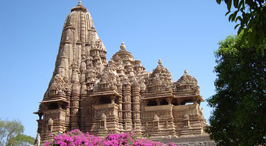
- Mobile
+91-9958308506
- E-Brochure
Download E-Brochure


The Khajuraho Group of Monuments in Khajuraho, a town in the Indian state of Madhya Pradesh, located in Chhatarpur District, about 620 kilometres (385 mi) southeast of New Delhi, is one of the most popular tourist destinations in India. Khajuraho has the largest group of medieval Hindu and Jain temples, famous for their erotic sculptures.
The name Khajuraho, ancient "Kharjuravāhaka", is derived from the Sanskrit words kharjura = date palm and vāhaka = "one who carries". Locals living in the Khajuraho village always knew about and kept up the temples as best as they could. They were pointed out to the English in the late 19th century when the jungles had taken a toll on the monuments. In the 19th century, British engineer T.S. Burt arrived in the area, followed by General Alexander Cunningham. Cunningham put Khajuraho on the world map when he explored the site on behalf of the Archaeological Survey of India and described what he found in glowing terms. The Khajuraho Group of Monuments has been listed as a UNESCO World Heritage Site, and is considered to be one of the "seven wonders" of India
Khajuraho is a town in the Indian state of Madhya Pradesh, located in Chhatarpur District, about 620 kilometres (385 mi) southeast of New Delhi, the capital city of India. According to the 2001 India census, Khajuraho has a population of 19,282. Males constitute 52% of the population and females 48%. The town has an average literacy rate of 53%, lower than the national average of 59.5%: male literacy is 62%, and female literacy is 43%. In Khajuraho, 19% of the population is under 6 years of age. Khajuraho is located at 24.85°N 79.93°E and has an average elevation of 283 metres (928 feet).
Khajuraho is served by Khajuraho Airport and there is a railway station in the centre of the town.
Some Bargujar moved eastward to central India; they ruled over the Northeastern region of Rajasthan, called Dhundhar, and were referred to as Dhundhel or Dhundhela in ancient times, for the region they governed. Later on they called themselves Chandelas; those who were in the ruling class having gotra Kashyap were definitely all Bargujars; they were vassals of Gurjara - Pratihara empire of North India, which lasted from 500 CE to 1300 CE and at its peak the major monuments were built. The Bargujars also built the Kalinjar fort and Neelkanth Mahadev temple, similar to one at Sariska National Park, and Baroli, being Shiva
The city was the cultural capital of Chandel Rajputs, a Hindu dynasty that ruled this part of India from the 10 to 12th centuries. The political capital of the Chandelas was Kalinjar. The Khajuraho temples were built over a span of 200 years, from 950 to 1150. The Chandela capital was moved to Mahoba after this time, but Khajuraho continued to flourish for some time. Khajuraho has no forts because the Chandel Kings never lived in their cultural capital.
The whole area was enclosed by a wall with eight originates, each flanked by two golden palm trees. There were originally over 85 Hindu temples, of which only 25 now stand in a reasonable state of preservation, scattered over an area of about 20 square kilometres (8 sq mi). The erotic sculptures were crafted by Chandella artisans. The temples, maintained by the locals, were pointed out to the English in the late 19th century when the jungles had taken a toll on the monuments. Today, the temples serve as fine examples of Indian architectural styles that have gained popularity due to their explicit depiction of sexual life during medieval times.You can see the erotic sculptures on Kandariya Mahadev Temple.

The temples are grouped into three geographical divisions: western, eastern and southern.
The Khajuraho temples are made of sandstone. The builders didn't use mortar: the stones were put together with mortise and tenon joints and they were held in place by gravity. This form of construction requires very precise joints. The columns and architraves were built with megaliths that weighed up to 20 tons.
The Saraswati temple on the campus of the Birla Institute of Technology and Science in Pilani, India, is modeled after the Khajuraho temples.
Maharaja Express Guest Always Special for us
 Comparison Chart
Comparison Chart Fact Sheet
Fact Sheet  History
History